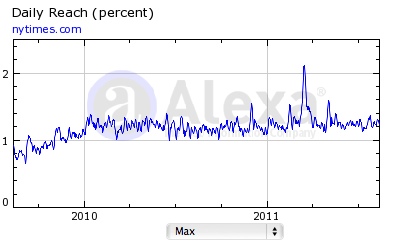On Porous Paywalls
Felix Salmon has a couple great posts on the New York Times' paywall. He notes that it has been successful and explains why. Felix says:
Yes, the NYT paywall is porous — but that’s a feature, not a bug. It allows anybody, anywhere, to read any NYT article they like. That makes the NYT open and inviting — and means that I continue to be very happy to link to NYT stories.
I've been a fan and a proponent of porous paywalls since studying the FT's model a few years back and was very pleased to see the NY Times go with the FT's model.
Monetizing digital content requires a different mindset than monetizing analog content. The marginal cost of another unit of digital content is nominal. Unlike printing and delivering a paper, serving up another page view doesn't cost the New York Times much. So while the New York Times must charge its customer to recieve the paper, it doesn't necessarily need to charge a customer for every page view, particularly since they do run ads on every page served.
This doesn't mean that the New York Times can't and shouldn't ask their most active readers to pay. My partner calls this ex post facto monetization. You get paid after the fact, not before. And that's a mindset that many people used to getting paid before the fact have a hard time understanding.
Felix explains that since turning on the "paywall" at the end of March, the New York Times has signed up almost 400,000 paying customers for its online product and links to Seth Mnookin's excellent NY Mag piece on the Times.
The internal projections have been closely held, but several people have confirmed that the goal was to amass 300,000 online subscribers within a year of launch. On Thursday, the company announced that after just four months, 224,000 users were paying for access to the paper’s website. Combined with the 57,000 Kindle and Nook readers who were paying for subscriptions and the roughly 100,000 users whose digital access was sponsored by Ford’s Lincoln division, that meant the paper had monetized close to 400,000 online users. (Another 756,000 print subscribers have registered their accounts on the Times’ website.)
These 400,000 subscribers have been obtained with seemingly no loss in visitors and traffic to the NY Times' website since the paywall launched at the end of March this year:
So that's $80mm in annual revenue with no loss in traffic. That's what a porous paywall can do for you.
I'd encourage the Times to be even more agressive with it's porous paywall stratgy. The mobile situation – where I have to pay for the mobile app but can read the website in the safari browser for free makes no sense. With ex post facto monetization, you want your customers to want to pay, not force them to pay. I think they can be smarter and more creative with their mobile monetization strategy.
But all in all, I'm very pleased to see that content creators are starting to find new online models to fund their content creation costs. It costs a lot of money to send journalists around the world reporting on the important stories of the day. Printing presses and delivery trucks will be a thing of the past someday. But journalism will never be a thing of the past and we need to make sure it can be funded.








